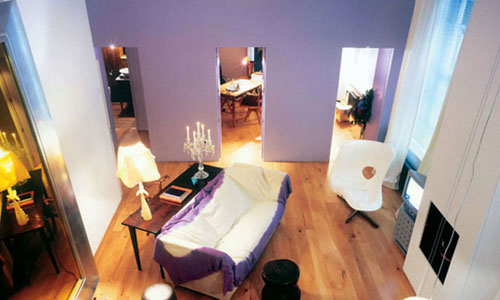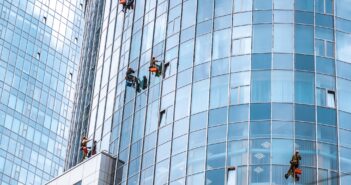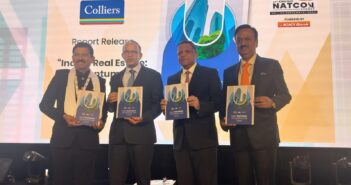
Lodha Group partners with Philippe Starck Partners
Lodha Developers have appointed the yoo design brand under the Creative Direction of Philippe Starck, to design a new residential development at New Cuffe Parade, Mumbai.

Lodha Developers have appointed the yoo design brand under the Creative Direction of Philippe Starck, to design a new residential development at New Cuffe Parade, Mumbai.

As the education sector evolves, factors such as technology permeation, revamped building designs, and focus on health & safety are likely to define education real estate. Besides, modern educational building design must prioritise flexibility so that spaces can be reconfigured to adapt to various teaching methods and activities, developing a dynamic learning environment. To address this and move away from traditional classroom setups, educational buildings now include collaborative spaces to encourage teamwork and group learning. Moreover, sustainable, and eco-friendly design elements, such as energy-efficient systems and natural lighting, are becoming increasingly common to reduce the environmental impact of educational buildings.

The surge in demand for luxury housing has been primarily attributable to a growing preference among affluent buyers for enhanced amenities and more spacious living areas that complement their multifaceted lifestyles. Moreover, the increasing aspirational class has significantly contributed to the increased demand for luxury properties. Furthermore, the rise in NRI and astute domestic investors in the Indian real estate market has considerably fueled the heightened demand for luxury residences.

Office leasing is likely to record a historic high of ~70 mn. sq. ft in CY 2024 across top 9 cities in India as per current estimates, says ‘CBRE India Office Figures Q3 2024’. The last highest office leasing was recorded in CY 2019 at 66.6 mn. sq. ft. The office demand will be driven by both global and domestic occupiers, who are expected to continue expanding their operations and consolidating their facilities to strengthen their market presence. GCCs are poised to expand significantly in India, accounting for about 35-40% of the total office leasing.

Q3 2024 attracted USD 1.1 Bn inflows, 45% higher over Q3 2023. Office segment drove over half of the investments in Q3 2024, followed by residential with 33% share. Domestic investments accounted for 44% of the total investments during the quarter. Chennai & Mumbai cumulatively attracted 57% of the inflows in Q3 2024. Sustained confidence in Indian economy continued to drive institutional investments into the real estate sector, reaching USD 4.7 billion during the first three quarters of 2024, almost at par with the corresponding period in 2023. Following significant inflows in the first two quarters, Q3 2024 too registered healthy investment inflow of about USD 1.1 billion, reflecting a 45% YoY growth.

97% of employees and 98% of employers in India surveyed by Unispace say they are satisfied with their hybrid working arrangement. Employees in India are least likely to spend time at their desks while working from the office (50% vs. 64% globally). Subsidized travel (i.e. parking or public transportation), access to training and development programs, and free drinks, coffee and snacks rank as the top three reasons for Indian employees to spend more time in the office. Worldwide, employers’ confidence in their workplace’s capacity to foster innovation shows a downward trend.

This long-term growth in real estate is underpinned by six salient growth levers which includes, rapid urbanization, infrastructure development, digitalization, demographic shifts, sustainability and investment diversification; all of which will form the bedrock for a quantum leap in Indian real estate by 2047. These long-term growth ingredients will be pivotal in the expansion of Indian real estate – from under a trillion currently, to potentially a USD 10 trillion market by 2047, accounting for a 14-20% share in the country’s GDP.

This strategic growth is expected to be driven by a focus on innovation as these companies seek to enhance their technological capabilities and market presence. Moreover, emerging technologies are projected to generate approximately 4.7 million tech jobs over the next five years across diverse sectors, including manufacturing, retail, education, finance, and insurance. This surge in job creation underscores the growing importance of technology across industries and highlights the need for a skilled workforce to meet the evolving demands of the digital economy.

Location continues to be of significant importance to occupiers, with about 60% respondents considering it as the most important parameter for expansion. Interestingly, while expanding, occupiers are likely to lean towards flex spaces with attractive offerings in central areas as compared to facilities in peripheral areas. Going ahead, about 45% of surveyed occupiers would opt for future expansion through flex spaces in CBD/SBD locations of tier I or tier II cities. In terms of work-place strategy, flex spaces are likley to champion distributed work models. About half of the larger companies including Global Capability Centers (GCCs) and MNCs envisage flex spaces to act as both hub and spoke offices in the next few years.

Bengaluru and Mumbai saw the highest leasing in green-certified buildings, accounting for over 50% share in Q2 2024. About 80% of Technology as well as Engineering & Manufacturing firms prefer taking up spaces in green-certified buildings. Majority of the upcoming supply in various construction stages is expected to be green-certified, expanding green office stock to over 600 mn sq ft in next 2-3 years.
